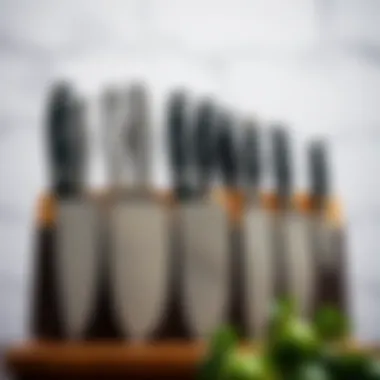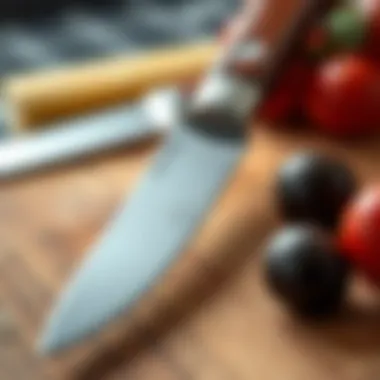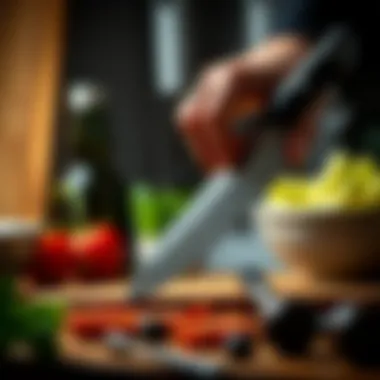The Ultimate Guide to Choosing Paring Knife Sets


Intro
Choosing the right paring knife set is not just about wielding a blade; it’s about embracing a tool that can enhance every aspect of your culinary journey. Paring knives are those versatile companions in the kitchen, essential for tasks like peeling, trimming, and intricate slicing.
The culinary landscape is vast, with numerous brands and styles to consider. As you sift through the options, it’s crucial to understand what makes a paring knife worthy of your countertop. That’s where this guide comes into play. By the end, you’ll not only know what features to look for but also which brands hold up against rigorous culinary demands.
Whether you’re a budding chef or a seasoned gourmet, the insights contained here will help you navigate through the clutter and find a paring knife set that meets your specific needs. Let's get this culinary adventure started!
Essential Features to Consider
Before delving into the best brands and sets available, let’s first talk about what really matters in a quality paring knife. Here are some key features to keep in mind:
- Blade Material: Look for high-carbon stainless steel for strength and resistance to rust. A ceramic blade can also be an option for its lightweight nature.
- Handle Comfort: A well-designed handle that fits comfortably in your hand can make all the difference. Materials like wood, plastic, or composite can affect both grip and aesthetics.
- Weight and Balance: Find a knife that feels natural in your hand. It shouldn’t be too heavy or too light, as this can influence precision and control.
- Blade Size: A standard paring knife is typically 3 to 4 inches long. However, the specific size you choose may depend on your personal preference and the tasks you’ll be performing.
Popular Brands
When it comes to reliability and performance, certain brands have made their mark in the culinary world. Here's a quick overview:
- Wüsthof: Renowned for their precision and longevity, Wüsthof offers a variety of paring knives that appeal to both professionals and home cooks alike.
- Victoria: Known for their sturdy design, Victoria paring knives are crafted from high-quality materials that promise durability.
- Shun: Merging traditional techniques with modern design, Shun knives are not only functional but also aesthetic, often crafted with beautiful patterns on their blades.
Maintenance Tips
Regardless of the knife you choose, maintaining it properly is essential for longevity:
- Regularly Sharpen Your Knives: Dull blades can lead to accidents. Keep a sharpening stone handy.
- Hand Wash: Avoid the dishwasher; instead, wash your knives with warm, soapy water and dry them immediately.
- Use a Knife Block or Magnetic Strip: Storing knives properly protects the blades and ensures they remain easily accessible.
“A dull knife is more dangerous than a sharp one. Knife safety starts with keeping your tools in prime condition.”
Finale
Selecting the best paring knife set isn't just a shopping task; it’s a significant investment in your cooking abilities. Knowing what features to prioritize and which brands excel will empower you as you navigate the countless options available. As you elevate your culinary skills, remember that a quality paring knife can make your kitchen adventures not only easier but also more enjoyable.
Intro to Paring Knives
Paring knives hold a unique place in the culinary toolkit, often sitting quietly next to their larger cousins yet packed in with a punch far beyond their size. Their importance can’t be overstated; these small yet mighty knives are essential for intricate tasks that larger blades simply can't handle. Whether you're peeling fruits, deveining shrimp, or crafting delicate garnishes, the precision of a paring knife is unparalleled.
Understanding the nuances of these knives isn’t just beneficial for seasoned chefs, but also for home cooks looking to enhance their skills. A good paring knife can make meal prep not only more efficient but also more enjoyable. With the right tool, the once mundane tasks of slicing and dicing transform into a more satisfying experience. But beyond the joy of cooking, selecting the right paring knife set plays a crucial role in overall kitchen efficiency.
Understanding the Paring Knife
A paring knife is generally defined by its short, slender blade, typically measuring between 2.5 to 4 inches long. The blade's design allows for a level of control that is essential for detailed tasks.
- Blade Design: The blade is often straight-edged, which leads to precise cuts, ideal for detailed work such as deveining or hulling strawberries.
- Weight: Generally lightweight, the paring knife offers ease of use, allowing for extended use without causing physical strain.
- Versatility: Although it's small, this knife is designed to be multifunctional. Its uses can range from preparing ingredients for a complex dish to simply slicing an apple.
The design and function of these knives vary significantly from other types of cutting tools. Their compact form not only makes them easy to handle but also reduces the risk of accidents, which is particularly useful for less experienced cooks.
The Role of a Paring Knife in Culinary Arts


A paring knife serves an essential role in elevating culinary practices. It allows chefs to showcase their precision and skill. Here are a few key points underscoring its significance:
- Precision Tasks: Tasks that require accuracy, such as trimming fat or cutting away skin, are best accomplished with a paring knife.
- Art of Presentation: When it comes to plating, garnishes make the dish. Using a paring knife can enhance visual appeal, making food not just a meal but an experience.
- Comfort in Handling: Its light weight and ergonomic designs with comfortable handles reduce fatigue, allowing for longer practice without weariness.
- Safety: Working with smaller blades can feel less intimidating. New cooks may find the control of a paring knife comforting as they develop their skills.
"A paring knife is the unsung hero of the kitchen. Its ability to perform detailed work makes it invaluable for achieving both artistry and function in cooking."
In summary, understanding paring knives not only equips you with knowledge but also prepares you to make informed purchasing decisions that will support your cooking journey. Choosing the right paring knife set can greatly influence your comfort and enjoyment in the kitchen. As we move forward, we will explore key features that distinguish quality paring knives from the rest.
Key Features of High-Quality Paring Knife Sets
When selecting a paring knife set, understanding the core features is crucial. These knives are not just a tool; they are an extension of a cook’s hand, bringing precision and finesse to intricate tasks. Knowing what to look for ensures you make an informed choice, enhancing both functionality and enjoyment in culinary endeavors.
Blade Material: Steel Versus Alternatives
Stainless Steel
Stainless steel is perhaps the most commonly used material for paring knife blades. This type offers excellent corrosion resistance, which is vital for kitchen tools subjected to moisture and acidic foods. A key characteristic of stainless steel is its durability. It can maintain sharpness longer than many materials, cutting down on frequent sharpening. The unique feature of stainless steel is that it often delivers a good balance between hardness and flexibility, making it easy to handle while still providing a capable cutting edge. However, it can be softer compared to other steels, which may lead to dulling over time if not properly cared for.
Carbon Steel
Carbon steel has gained a dedicated following among culinary professionals for its ability to take and hold a sharp edge exceptionally well. The main advantage of carbon steel lies in its remarkable sharpness, which allows for precision cuts that can make all the difference in delicate food prep. Its less corrosion-resistant nature means it requires diligent maintenance to prevent rust and staining, which can be a downside. However, many chefs argue that the ability to easily sharpen it and the performance you get when it is sharp makes it worth the extra effort.
High Carbon Stainless Steel
High carbon stainless steel attempts to combine the best of both worlds: the sharpness and easy sharpening of carbon steel with the corrosion resistance of stainless steel. This material is a popular choice among both novice and experienced cooks due to its superior edge retention and resilient construction. A notable feature of high carbon stainless steel is its ability to resist stains, which means less maintenance overall while still performing exceptionally well cutting wise. One disadvantage could be the price point; it often comes with a heftier price tag than standard stainless steel blades.
Handle Design and Comfort
Ergonomics
When it comes to paring knives, a comfortable handle can be the difference between kitchen drudgery and culinary creativity. Ergonomics refers to the study of people's efficiency in their working environment. A well-designed handle will fit comfortably in the hand, minimizing strain during prolonged use. The key characteristic here is grip security, which allows for controlled movements while cutting. Poor ergonomics can lead to discomfort and even fatigue, affecting the quality of your work and enjoyment in the kitchen. Thus, investing in a handle that supports your hand naturally can significantly enhance your experience.
Material Choices: Wood, Plastic, and Metal
Selecting the right material for knife handles is as important as the blade itself. Wooden handles, often appreciated for their aesthetic warmth, can provide a good grip and often feature a traditional appeal. Plastic handles offer a lightweight option and can come in a variety of colors, allowing for personalization. On the other hand, metal handles tend to be very durable and can match the sleek style of the knife overall. The downside? Plastic may not provide the same level of comfort compared to wood, and metal may feel slippery without proper texture. Knowing your preference can help dictate the handle's material.
Blade Length and Shape Considerations
Common Lengths
Typically, paring knives range from around 2.5 inches to 4 inches in blade length. Choosing the right length is about balance—too long can lead to loss of control for intricate tasks; too short may not perform well in broader cutting tasks. The key characteristic here is versatility, as different culinary tasks may require different lengths based on ease and efficiency. When selected thoughtfully, the right length can mean smoother cutting and an overall enhanced experience in food preparation.
Blade Shape Types
Blade shapes are crucial to how a paring knife performs tasks. Some blades have a straight edge, while others may feature a curved or pointed tip for maneuvering around tight spots, like peeling or trimming. The unique feature of a blade’s shape is how it influences precision and comfort—some are better suited for certain tasks than others. Choosing a blade shape that aligns with your cooking style can elevate your culinary pursuits significantly.
Selecting a paring knife set that encompasses high-quality features sets the stage for a remarkable culinary journey.
Top Paring Knife Sets on the Market


When it comes to selecting the best paring knife set, understanding what’s available on the market is crucial. Paring knives are the small, versatile members of the knife family, handling everything from peeling fruits to intricate garnishing. A well-chosen set can serve you for years, making meal preparation more enjoyable and efficient. But with a multitude of options sprouting up like daisies, how do you navigate these waters?
In this section, we’ll dive into three notable brands—each with its own unique attributes that make them stand out in a crowded field. Your choice depends on personal preferences and specific needs, from professional culinary use to casual home cooking. Recognizing the key features of each brand can help you make an informed decision. Let's take a closer look.
Brand A: Overview and Key Features
Brand A has carved a niche for itself by combining traditional craftsmanship with modern technology. These knives boast high-carbon stainless steel blades, ensuring they remain sharp and durable over time. Users often rave about their balance; they feel substantial in hand without being cumbersome, which is important for precision tasks. Ergonomically designed handles contribute to a comfortable grip, reducing hand fatigue during extensive use.
In addition, Brand A offers a range of blade shapes that cater to different cutting styles—perfect for food lovers looking to improve their culinary skills or chefs demanding versatility in their tools. Their knives generally come with a lifetime warranty, reflecting the brand's confidence in its quality.
"A well-balanced knife isn’t just a tool; it's an extension of the chef’s hand."
Brand B: Overview and Key Features
Next up, we have Brand B, famous for its minimalist design and exceptional performance. Their paring knives often feature wide, tapered blades, making them ideal for both slicing and delicate detail work. The focus here is on functionality without sacrificing style. Most users appreciate the aesthetic appeal, which speaks to those who value kitchen tools as part of their home decor.
An interesting aspect of Brand B is its emphasis on sustainability. The handles are crafted from renewable materials, catering to a growing segment of eco-conscious consumers. Furthermore, reviews commonly highlight their ease of maintenance, adding to their allure.
Brand C: Overview and Key Features
Finally, Brand C enters the fray with a robust selection aimed at professional chefs and home cooks alike. Renowned for their ultra-sharp blades, this brand excels in cutting precision, making mincing and dicing tasks a breeze. Notably, their knives are designed to keep the edge longer than most competitors, a significant factor for any serious cook.
Brand C also offers customizable options, allowing users to choose handle materials and colors—perfect for those looking to personalize their kitchen gear. Their commitment to quality craftsmanship doesn't stop at the blade; these knives generally feel very durable and come with thoughtful features such as riveted handles for added strength.
Choosing the right paring knife set is more than just about aesthetics; it encompasses functionality, comfort, and ultimately, the joy of cooking. By understanding what each brand brings to the table, you can narrow down your choices and find a set that fits beautifully into your culinary journey.
Factors to Consider When Choosing a Paring Knife Set
Selecting the right paring knife set goes beyond just picking the first shiny options you find. This tool is often the unsung hero in every kitchen, playing a crucial role in the precision and efficiency of food preparation. Factors like culinary needs, personal preferences, budget, and maintenance are essential elements that dictate the best choice.
A paring knife can serve a variety of functions – from peeling fruits to deveining shrimp – every cook’s tasks differ, and so do their preferred tools. Understanding these factors not only aids in discovering a suitable set but also improves the overall cooking experience.
Culinary Uses and Personal Preferences
When selecting a paring knife set, it’s vital to consider how and where you usually use these knives. Each cook has different habits and styles that affect their choice. For instance, if you often find yourself working with small precision tasks, like coring apples or trimming herbs, you might look for a smaller blade that offers more control. On the other hand, for larger fruits and vegetables, you may prefer a longer knife that provides good leverage.
Additionally, personal preference in handle style and grip comfort plays a significant role in how well you can maneuver the knife during use. A knife that feels good in your hand will naturally enhance your skills.
Budget Constraints: Finding Value
Investing in a paring knife set can range from chalkboard to top-dollar, depending on the brand and quality. While it’s tempting to go for the cheapest option available, it’s important to understand that some knives might not hold their edge or break after a short time.
Thus, establishing a budget while keeping an eye on the long-term value is vital. Often, a moderately priced set can offer superior performance compared to less expensive models that wear out quickly. Consider searching for manufacturer warranties or satisfaction guarantees – these can be indicators of quality and durability.
Knife Maintenance and Care
Proper care can extend the life of your paring knife set considerably. Knowing how to maintain this essential tool is often overlooked, yet it’s one of the fundamental steps to ensure it stands the test of time.


Sharpening Techniques
One cannot stress enough the significance of regular sharpening. Whether using a whetstone, honing rod, or electric sharpener, each method comes with its own set of benefits and quirks. A whetstone, for instance, provides a precise sharpening angle, giving you full control over the blade's edge. However, it requires some skill and practice.
An electric sharpener can be super quick but may compromise the blade on softer steels. Regular maintenance keeps the blade in peak condition, ensuring consistent cutting precision which ultimately leads to better-looking fruits and vegetables, plus a more enjoyable cooking experience.
Storage Solutions
Once you’ve found the perfect knife, you’ll also need to think about how and where to store it. A good storage solution can prevent blades from getting dull or damaged. Storage blocks, magnetic strips, or protective sheaths all serve different purposes but must align with your kitchen’s style and the space available.
Using a block can help keep blades secure, while magnetic strips can save space and allow for easy access – just grab and go. Each of these options has its own pros and cons, so choose what fits your kitchen needs best. Remember, investing in proper storage is just as vital as the knife itself.
"The key to a successful paring knife selection is not just about the blade’s sharpness or the fitting handle, it’s about how well you understand your cooking habits and needs."
Comparative Review: Best Paring Knives Features
A solid understanding of the best features in paring knives can greatly influence your satisfaction and effectiveness in the kitchen. This comparative review focuses on the essential traits to consider while selecting your ideal paring knife set. From performance to user insights, grasping these elements can drive home the message that not all knives are created equal.
Performance Analysis
Cutting Precision
When it comes to cutting precision, this characteristic stands out as the cornerstone in the functionality of a paring knife. A well-crafted blade allows you to slice through ingredients, no matter how intricate the task. Whether you're peeling a delicate fruit or creating intricate garnishes, the precision of the blade is paramount. High-quality paring knives, like those made with high carbon stainless steel, offer exceptional sharpness that holds up over time, making them a beneficial choice for any cooking enthusiast.
The unique feature of cutting precision lies in the blade's edge—maintaining a sharp angle helps achieve clean cuts, thus enhancing control and minimizing waste. One disadvantage can be the maintenance needed; frequent sharpening is essential to keep the edge from dulling over time, but that’s often the price of quality.
Durability Factors
Durability factors in paring knives cannot be overlooked. The materials used in the blade and handle directly affect longevity, with options ranging from stainless steel to more traditional carbon blades. Stainless steel, for instance, resists rust, while carbon options tend to be favored for their ability to retain a sharper edge longer.
One particularly appealing characteristic of durable paring knives is their resistance to wear and tear. A durable option is not just a one-time investment; it becomes a companion in your culinary journey, capable of standing the test of time. However, it’s worth noting that while durability is a plus, it may add weight to the knife, which isn’t preferred by everyone.
User Feedback and Expert Opinions
In the kitchen realm, user feedback and expert opinions play an indispensable role in shaping your choice. By sifting through reviews and analysis, one can obtain a nuanced perspective that goes beyond mere specifications. Many chefs echo the sentiment that the right knife can elevate cooking from a chore to a satisfying experience.
A common thread among feedback often centers on the balance of the knife, the comfort of the handle, and the sharpness retention over time. Experts often recommend testing various knives for fit and feel before making a purchase. The weight, handle material, and overall balance contribute to what feels right for each user's distinct preference. In the end, a paring knife isn't just about cutting; it's also about how confident you feel wielding it.
Remember: The right paring knife can be a game changer, providing precision and comfort, making every cutting task a breeze!
Culmination
In the realm of culinary tools, a paring knife set stands out as an essential companion for both budding chefs and seasoned professionals. Understanding its significance underscores not only the skill involved in food preparation but also the joy it brings to the cooking experience. In this article, we've emphasized that selecting the right paring knife set can dramatically impact various tasks, from intricate peeling to precision slicing.
Recap of Key Takeaways
- Versatility: Paring knives excel in tasks that demand finesse. Be it removing seeds from a jalapeño or creating decorative cuts, these knives are designed for precision.
- Material Matters: The choice between stainless steel, carbon steel, and high carbon stainless steel can fundamentally affect the knife's performance and maintenance requirements. Understanding these materials helps in making the right choice.
- Ergonomics is Key: A comfortable handle can make all the difference in the ease of use and safety during food prep. The material and design of the handle need careful consideration, as this impacts your grip and control.
- Budgeting Smartly: Finding a paring knife set that balances quality and cost is crucial. Investing in a reliable set might save money in the long run, especially when considering the durability and performance of well-crafted knives.
Final Recommendations
When selecting a paring knife set, prioritize what aligns best with your culinary style and preferences. Paying attention to the quality of the blade, the comfort of the handle, and the overall construction will serve you well in the kitchen.
- Consider Testing Before Buying: If possible, get a feel for the knife in person. A knife should feel like an extension of your hand, not a foreign tool.
- Look for Warranty Offers: A good warranty often indicates a brand's confidence in their product. It's wise to consider manufacturers that provide substantial warranties.
- Explore Reviews and Ratings: Don’t overlook user feedback. Insights from other cooks can guide you, helping to refine your choices based on their experiences.
Ultimately, selecting the right paring knife set is not just about the tools but enhancing your cooking experience overall. With the proper knowledge and approach, you'll find that this little knife can wield significant power in the culinary world.







